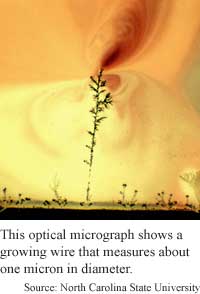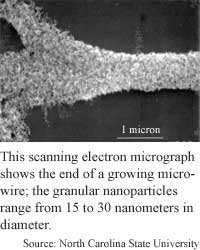
Electrified
water spins gold into wire
By
Kimberly Patch,
Technology Research NewsOne approach to building microscopic devices is getting tiny particles of material to simply fall into place.
Researchers from North Carolina State University have found a way to coax microscopic gold particles to assemble into wires that are five times thinner than the diameter of a red blood cell.
The researchers put a pair of electrodes into water suffused with gold particles, pumped an alternating current of electrons through, and found that the free particles aggregated at the ends of the electrodes and eventually grew into a wire connecting them. An alternating current constantly switches the direction electrons are traveling along a wire.
"The particles are brought to a high concentration in the end of the wire because that is where the electric field is strongest, and once they are present there in high concentrations they aggregate," increasing the length of the wire, said Eric Kaler, a professor of chemical engineering at North Carolina States.
The effect had not been predicted. "The whole process is surprising. Theory does not predict this phenomenon, and it has not been seen before," Kaler said.
The nature of the process makes the wires self-repairing. When the researchers increased the current through the microwire to the point where the wire snapped, the electric field at the break attracted new particles to aggregate near the gap and restore the connection, according to Kaler.
By changing the strength and location of the electric fields, the researchers were able to make the wires branch in a way similar to frost forming on a window. The researchers also used the method to coax microparticles of latex to aggregate along with the gold in order to grow gold wires surrounded by an insulator, according to Kaler.
One of the most useful things about the process is it happens in water. "These wires can connect circuits underwater, so that provides a means to connect... aqueous structures like cells to electronic devices," said Kaler. There is still work to be done to achieve this, he added. The challenge is preserving the cells in the electrical environment needed to build the wires. "But there is a good chance it could work," he said.
The wires also have potential as chemical sensors. They can be coated with single-molecule layers of substances that bind to, or physically connect with, certain chemicals, said Kaler. The electrical resistance of the wire changes when the chemicals are bound to this outer layer, causing electrons to travel through it at different speeds that can be correlated to the concentration of the chemical.
In the researchers' experiments, wires one micron in diameter grew at speeds ranging from 50 microns to 500 microns a second. The faster speed is quick enough to bridge a one-centimeter gap between electrodes in less than half a minute. A micron is one thousandth of a millimeter; a red blood cell is five microns in diameter, and an E. coli bacterium is one micron in diameter.
One advantage of the method is it does not require a physical template to map out where the wires are going to grow. Instead, the wire assembly "is driven by an external field," said Kaler. Because the strength and location of the electric field guides both the rate and location of the growth, the method is less tedious and expensive than current template methods, he said. The method could be used commercially at any time, he added.
The researchers are looking to build more organized structures using the method, said Kaler. "Ultimately we would like a toolbox of approaches to build nanostructures" in place, he said.
Kaler's research colleagues were Kevin D. Hermanson, Simon O. Lumsdon, Jacob P. Williams, and Orlin D. Velev from North Carolina State University. They published the research in the November 2, 2001 issue of Science. The research was funded by the National Science Foundation.
Timeline: Now
Funding: Government
TRN Categories: Nanotechnology; Materials Science and Engineering
Story Type: News
Related Elements: Technical paper, "Diclectrophoretic Assembly of Electrically Functional Microwires from Nanoparticle Suspensions," Science, November 2, 2001.
Advertisements:
November 7, 2001
Page One
Hubs key to Net viruses
Electrified water spins gold into wire
Virtual reality gets easier
Laser emits linked photons
Dye brightens micromachines


News:
Research News Roundup
Research Watch blog
Features:
View from the High Ground Q&A
How It Works
RSS Feeds:
News
Ad links:
Buy an ad link
| Advertisements:
|
 |
Ad links: Clear History
Buy an ad link
|
TRN
Newswire and Headline Feeds for Web sites
|
© Copyright Technology Research News, LLC 2000-2006. All rights reserved.